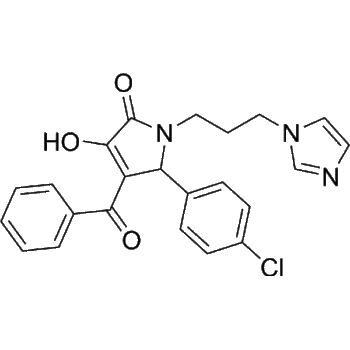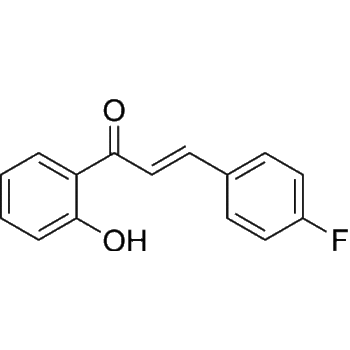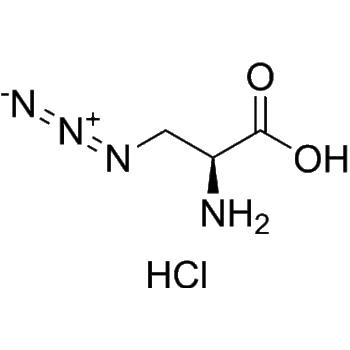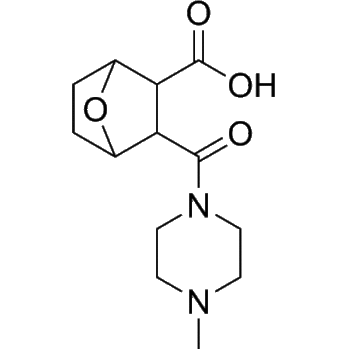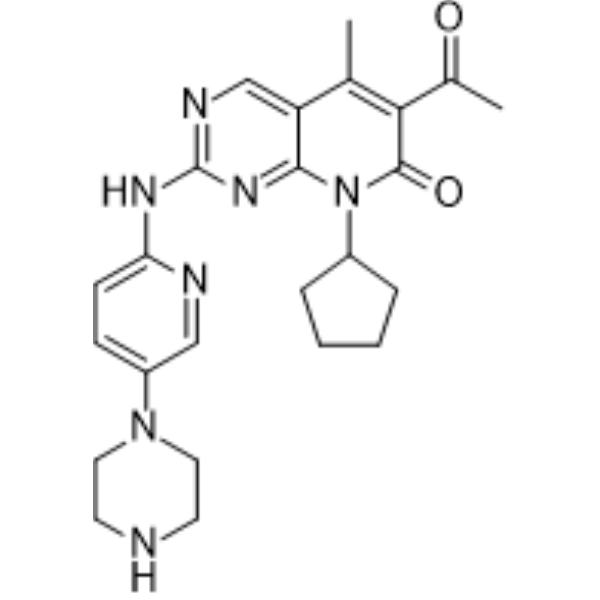
Download Files:
Palbociclib
$60 – $312
Products Details
Product Description
– Palbociclib (PD 0332991) is an orally active selective CDK4 and CDK6 inhibitor with IC50 values of 11 and 16 nM, respectively. Palbociclib has potent anti-proliferative activity and induces cell cycle arrest in cancer cells, which can be used in the research of HR-positive and HER2-negative breast cancer and hepatocellular carcinoma[1][3][4].
Web ID
– HY-50767
Storage Temperature
– 4°C (Powder, protect from light)
Shipping
– Room Temperature
Applications
– Cancer-Kinase/protease
Molecular Formula
– C24H29N7O2
Citations
– Acta Biomater. 2022 Aug 1;S1742-7061(22)00455-X.|Am J Transl Res. 2019 Sep 15;11(9):6055-6065.|Biochem Biophys Res Commun. 2023 Apr 2;650:96-102.|Biochem Pharmacol. 2017 Jan 15;124:29-42.|Biochim Biophys Acta. 2017 Nov 20;1865(2):354-363.|bioRxiv. 2023 Nov 23.|bioRxiv. 2023 Sep 18.|Br J Cancer. 2021 Jan;124(1):191-206.|Br J Cancer. 2022 Jan 14.|Cancer Cell. 2017 Apr 10;31(4):576-590.e8. |Cancer Res. 2019 Oct 15;79(20):5245-5259.|Cancer Res. 2021 Jan 1;81(1):187-198.|Cancer Res. 2023 Apr 18;CAN-22-3484.|Cancer Res. 2023 Oct 6.|Cancers (Basel). 2021, 13(7), 1494.|Cancers (Basel). 2023 Mar 22;15(6):1908.|Cancers. 2020 Jun 16;12(6):1596.|Cell Chem Biol. 2018 Feb 15;25(2):135-142.e5.|Cell Chem Biol. 2019 Aug 15;26(8):1067-1080.e8. |Cell Death Differ. 2020 Jun;27(6):1981-1997.|Cell Death Differ. 2022 Jan 20.|Cell Death Dis. 2020 Apr 6;11(4):219. |Cell Death Dis. 2020 Sep 15;11(9):760.|Cell Death Dis. 2022 Apr 2;13(4):295.|Cell Mol Gastroenterol Hepatol. 2022 Jul 14;S2352-345X(22)00163-1.|Cell Prolif. 2022 Sep 20;e13337.|Cell Rep. 2022 Aug 16;40(7):111194.|Cell Rep. 2022 Nov 15;111716.|Cell Syst. 2018 Apr 25;6(4):424-443.e7.|Cell Syst. 2019 Jul 24;9(1):35-48.e5. |Cell Rep. 2020 Apr 14;31(2):107514.|Clin Cancer Res. 2021 Apr 1;27(7):1855-1863.|Department of Biochemistry. 2020 Oct.|Dev Cell. 2023 Sep 9;S1534-5807(23)00443-4.|Development. 2023 Apr 5;dev.200903.|EBioMedicine. 2019 May;43:171-179. |EBioMedicine. 2019 May;43:225-237. |EMBO J. 2021 Apr 15;e99692.|EMBO Rep. 2022 Apr 11;e53932.|Endocrinology. 2023 Sep 13;bqad135.|Exp Cell Res. 2020 Aug 1;393(1):112054.|Front Cell Dev Biol. 2020 Aug 31;8:843.|Front Oncol. 2022 Apr 8;12:819003.|Future Med Chem. 2018 Dec 17. |Harvard Medical School LINCS LIBRARY|Inflamm Res. 2023 May 11.|Int J Biol Sci. 2019 Jan 1;15(3):522-532. |Int J Biol Sci. 2021; 17(3): 728-741.|Int J Mol Sci. 2019 Mar 5;20(5). pii: E1125. |Int J Mol Sci. 2021, 22(7), 3367.|Int J Mol Sci. 2023 Mar 12.|iScience. 6 September 2022, 105081.|J Biol Chem. 2023 May 3;104786.|J Biol Chem. 2023 Oct 17.|J Bone Oncol. October 2021, 100391.|J Cell Mol Med. 2021 Mar;25(6):3124-3135.|J Exp Clin Cancer Res. 2018 Sep 20;37(1):233.|J Med Chem. 2021 Jul 21.|J Med Chem. 2021 Oct 21.|J Oncol. 27 Sept 2022.|J Transl Med. 2019 Aug 20;17(1):276.|JCI Insight. 2021 Apr 8;6(7):139497.|Leuk Res. September 2022, 106920.|Life Sciences. 2023 Apr 1, 121652.|Mar Drugs. 2020 Sep 27;18(10):494.|MedComm. 10 June 2022.|Mol Cell. 2017 Oct 19;68(2):336-349.e6.|Mol Cell. 2023 Oct 5;83(19):3558-3573.e7.|Mol Oncol. 2023 Sep 13.|Mol Ther-Nucl Acids. 2023 Mar.|Molecules. 2023 May 27, 28(11), 4380.|Nat Commun. 2018 Oct 9;9(1):4180. |Nat Commun. 2020 Aug 13;11(1):4053.|Nat Commun. 2021 Jul 22;12(1):4457.|Nat Commun. 2021 Nov 16;12(1):6607.|Nat Commun. 2023 Jul 14;14(1):4221.|Nat Commun. 2019 Nov 7;10(1):5076. |Nat Methods. 2022 Mar;19(3):331-340.|Nature Cancer. 2021 Jan;2(1):34-48.|Nature. 2017 Aug 24;548(7668):471-475. |Nature. 2020 Jul;583(7817):620-624.|Neoplasia. 2018 Mar 28;20(5):478-488. |NPJ Precis Oncol. 2021 Mar 19;5(1):20.|Oncogene. 2022 Jun 9.|Patent. US11761044.|Patent. US20200108066A1|Patent. US20230149350A1.|PRACTICAL ONCOLOGY JOURNAL. 2018, 32(3): 193-197.|Practical Oncology Journal. 2018,32(03):193-197.|Research Square Preprint. 2021 Apr.|Research Square Preprint. 2021 Dec.|Research Square Preprint. 2023 May 9.|Research Square Preprint. 2023 Nov 30.|Sci Rep. 2021 Mar 8;11(1):5374.|Sci Rep. 2023 Jan 31;13(1):1711.|Sci Transl Med. 2018 Jul 18;10(450):eaaq1093.|Technischen Universität Dresden . 11 June 2021.|Technischen Universität München. Fakultät für Medizin.|University of Coruña. Facultade de Ciencias da Saúde. 2022 Oct.|University of Coruña. Facultade de Ciencias. 2022 Jan.|University of Dundee. 2023 Jan.|University of Texas. UTHealth Graduate School of Biomedical Sciences. 2021 Sep.|World J Surg Surgical Res. 2023 Jun 28.|Aging Cell. 2022 Mar 9;e13580.|bioRxiv. 2023 Mar 30.|bioRxiv. 2023 Sep 16.|Cancer Res. 2023 Jun 29;CAN-23-0705.|Cell Rep. 2019 Mar 5;26(10):2667-2680.e7.|EMBO J. 2022 Feb 14;e109760.|J Virol. 2023 May 23;e0037023.|Laurentian University. Chemical Sciences. 2021 Oct.|Mol Cancer. 2022 Aug 30;21(1):171.|Nat Commun. 2021 Aug 25;12(1):5112.|Nat Commun. 2022 Aug 10;13(1):4689.|Nature. 2020 Dec;588(7836):169-173.|NPJ Breast Cancer. 2021 Jan 4;7(1):2.|Syddansk Universitet. 2023 May 22.|bioRxiv. 2023 Mar 15.|Cancer Res. 2022 Apr 11;canres.3565.2021.|Cell Rep. 2022 Mar 1;38(9):110448.|Cell Rep. 2023 Mar 30;42(4):112314.|Ecotoxicol Environ Saf. 2020 Dec 1;205:111146.|Eur J Cancer. 2018 Oct;102:10-22.|J Pathol. 2023 Feb 24.|J Transl Med. 2023 Feb 10;21(1):110.|Mol Cancer Res. 2018 Mar;16(3):361-377. |Mol Cell. 2020 Jun 18;78(6):1096-1113.e8. |Mol Cell. 2023 Nov 16;83(22):4062-4077.e5.|Mol Oncol. 2017 Aug;11(8):1035-1049.|Nature. 2017 Jun 15;546(7658):426-430.|University College Dublin. School of Biology and Environmental Science.
References
– [1]Fry DW, et al. Specific inhibition of cyclin-dependent kinase 4/6 by PD 0332991 and associated antitumor activity in human tumor xenografts. Mol Cancer Ther. 2004 Nov;3(11):1427-38. |[2]Goel S, et al. CDK4/6 inhibition triggers anti-tumour immunity. Nature. 2017 Aug 24;548(7668):471-475. |[3]Richard S Finn, et al. PD 0332991, a selective cyclin D kinase 4/6 inhibitor, preferentially inhibits proliferation of luminal estrogen receptor-positive human breast cancer cell lines in vitro. Breast Cancer Res. 2009;11(5):R77. |[4]Bollard J, et al. Palbociclib (PD-0332991), a selective CDK4/6 inhibitor, restricts tumour growth in preclinical models of hepatocellular carcinoma. Gut. 2017 Jul;66(7):1286-1296.
CAS Number
– 571190-30-2
Molecular Weight
– 447.53
Compound Purity
– 99.97
SMILES
– O=C1C(C(C)=O)=C(C2=CN=C(N=C2N1C3CCCC3)NC4=CC=C(N5CCNCC5)C=N4)C
Clinical Information
– Launched
Research Area
– Cancer
Solubility
– 0.1 M HCL : 25 mg/mL (ultrasonic;adjust pH to 4 with 0.1 M HCL)|DMSO : 11.11 mg/mL (ultrasonic;warming;adjust pH to 4 with 1M HCl;heat to 60°C)|H2O : < 0.1 mg/mL
Target
– CDK
Isoform
– CDK4;CDK6
Pathway
– Cell Cycle/DNA Damage
Product type
– Reference compound
Disclaimer: All products are for Research use only unless clearly stated otherwise on the product datasheet. Datasheets provided on the website are drafts for reference purpose only and you are requested to always refer to the hard copy included in the kit for your experimentation. Agdia Products are available for delivery only in Canada.
